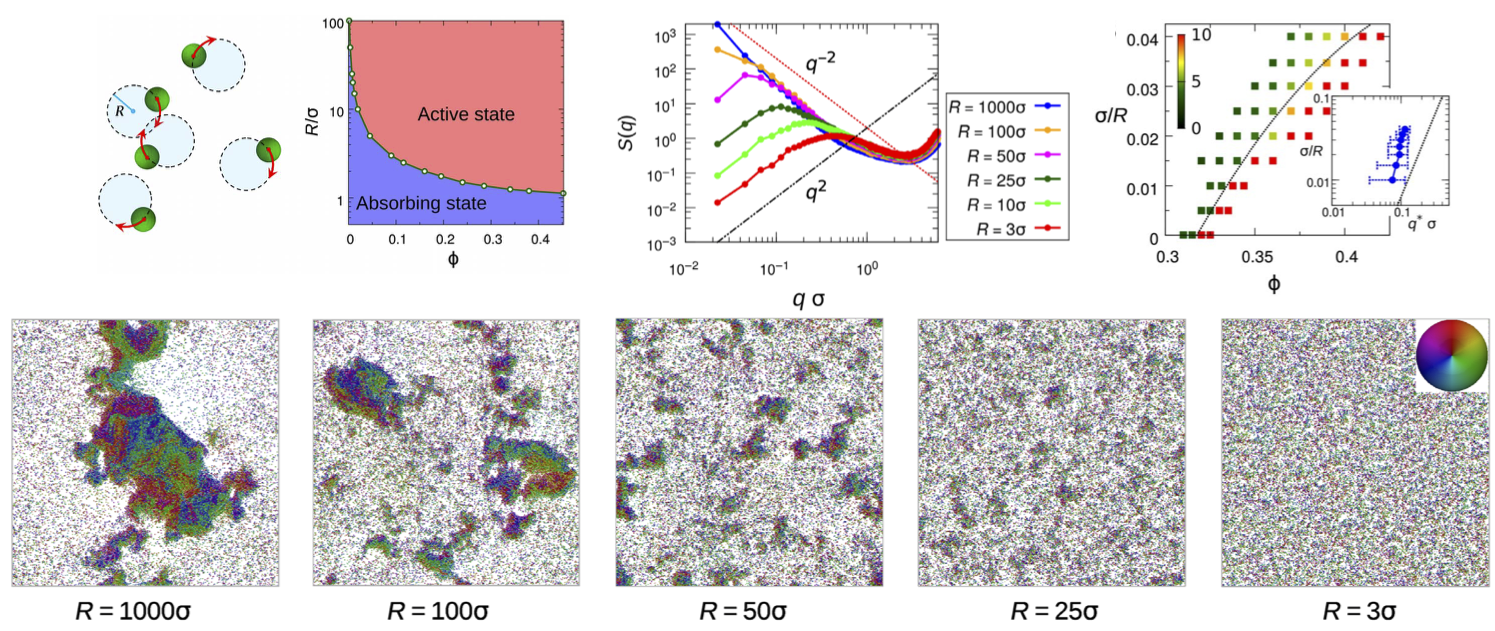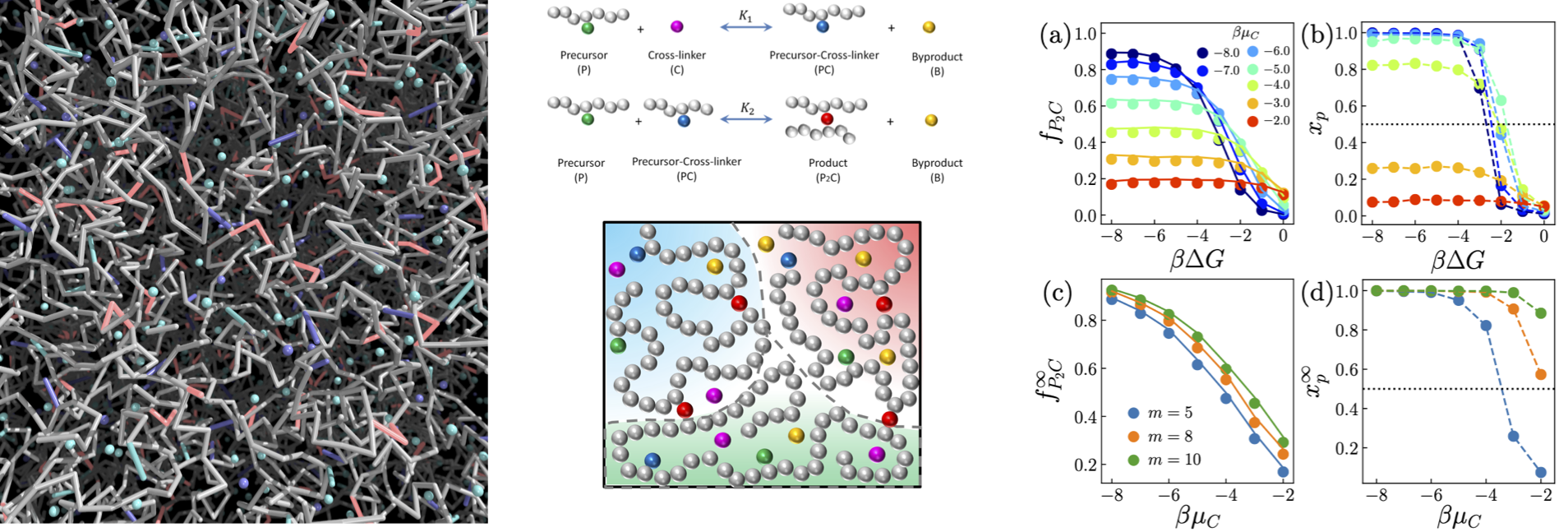

| Home |
Members |
Research | Publications | Vacancies | Teaching |
| Research Interests |
| 1.
Dynamic assembly of active matter Active matter are these particles or objects which can convert biological or chemical energy to drive their motion. Therefore, active matter systems are intrinsically out of equilibrium, and the special non-equilibrium dynamics has driven the formation of many interesting emergent structures and collective dynamics in systems of active matter. We are aiming to study the dynamic non-equilibrium self-assembly in active matter systems and use active matter as a tool to manipulate and drive the self-assembly of passive matter systems in order to introduce new techniques using active matter as an agent to help the fabrication of functional materials. In particular, we are interested in the glass transition, crystallisation and the effective interaction in active matter systems.  |
| [1] R. Ni, et al., Nature Communications,
4, 2704 (2013) [2] R. Ni, et al., Soft Matter, 10 (35) 6609 (2014) [3] R. Ni, et al., Phys. Rev. Lett., 114, 018302 (2015) [4] Z. Ma, Q. Lei, and R. Ni*, Soft Matter, 13, 8940 (2017) [5] Z. Ma, M. Yang, and R. Ni*, Adv. Theory Simul., 3, 2000021 (2020) [6] Z. Ma, and R. Ni*, J. Chem. Phys., 156, 021102 (2022) |
| 2. Non-equilibrium hyperuniform fluids Disordered hyperuniform structures are an exotic state of matter having vanishing long-wavelength density fluctuations similar to perfect crystals or quasi crystals but without long-range order. The concept of hyperuniformity was introduced by Torquato and Stillinger in 2003, and its importance in materials science has been brought to the fore in past decades. Because strongly hyperuniform disordered structures were found to exhibit similar properties as crystals with even better performance, e.g. large isotropic photonic bandgaps insensitive to defects can be opened at low dielectric contrast. Although a number of disordered hyperuniform structures have been found, e.g. maximally random jammed packing, avian photoreceptor patterns, and some non-equilibrium systems, the rational design of experimentally realizable disordered strongly hyperuniform microstructures remains challenging. Recently, we find a new type of non-equilibrium fluid with strong hyperuniformity in two-dimensional systems of chiral active particles, where particles perform independent circular motions of the radius R with the same handedness. This new hyperuniform fluid features a special length scale, i.e. the radius of the circular trajectory of particles, below which large density fluctuations are observed. By developing a dynamic mean-field theory, we show that the large local density fluctuations can be explained as a motility-induced microphase separation, while the Fickian diffusion at large length scales and local center-of-mass-conserved noises are responsible for the global hyperuniformity. Moreover, we formulate the first hydrodynamic theory for describing the non-equilibrium hyperuniform fluids.  |
| [1] Q. Lei, M. Pica Ciamarra, and R. Ni*, Science Advances, 5, eaau7423 (2019) [2] Q. Lei, and R. Ni*; Proc. Natl Acad. Sci. USA, 116, 22983 (2019) [3] Y. Lei, and R. Ni*; Proc. Natl Acad. Sci. USA, 120, e2312866120 (2023) [4] Y. Lei, and R. Ni*; J. Chem. Phys., 159, 081101 (2023) |
| 3. Addressable assembly of DNA coated colloids An immense challenge in materials sciences is to find a way to construct materials with absolute control over the placement of each building block in order to tailor properties for given applications. DNA coated colloids offer the possibility of realizing programmable self-assembly, which in principle can assemble almost any structure in equilibrium, while remains challenging experimentally. Here, we use computer simulation combined with analytical theories to develop new systems of linker-mediated DNA coated colloids, in which one could avoid the high temperature sensitivity in the designed specific colloidal interaction. This suggests new possiblities of experimentally addressable assembly to realize the dream of large scale designed fabrication of nano/micro devices.  |
| [1] H. Hu, P. Sampedro Ruiz, and R. Ni*, Phys. Rev. Lett., 120, 048003 (2018) [2] X. Xia, H. Hu, M. Pica Ciamarra, and R. Ni*, Science Advances, 6, eaaz6921 (2020) [3] X. Xia, and R. Ni*, Phys. Rev. Lett., 132, 118202 (2024) |
4. Linker-mediated Vitrimers Recently developed linker-mediated vitrimers based on metathesis of dioxaborolanes with various commercially available polymers have shown both good processability and outstanding performance, such as mechanical, thermal, and chemical resistance, suggesting new ways of processing crosslinked polymers in industry, of which the design principle remains unknown [1]. We formulate a theoretical framework to elucidate the phase behaviour of the linker-mediated vitrimers, in which entropy plays a governing role. We find that with increasing the linker concentration, vitrimers undergo a reentrant gel-sol transition, which explains a recent experiment [2]. More intriguingly, at the low temperature limit, the linker concentration still determines the crosslinking degree of the vitrimers, which originates from the competition between the conformational entropy of polymers and the translational entropy of linkers. Our theoretical predictions agree quantitatively with computer simulations, and offer guidelines in understanding and controlling the properties of this newly developed vitrimer system [3].  |
| [1] M. Rottger, et al., Science 356, 62
(2017) [2] S. Wu, et al., Macromolecules, 53, 1180 (2020) [3] Q. Lei, X. Xia, J. Yang, M. P. Ciamarra, and R. Ni*, Proc. Natl Acad. Sci. USA 117, 27111 (2020) [4] X. Xia, P. Rao, J. Yang, M. P. Ciamarra, and R. Ni*, JACS Au 2, 2359 (2022) |
5. Deep learning neural network assisted rare events sampling From physics and biology to seismology and economics, the behaviour of countless systems is determined by impactful yet unlikely transitions between metastable states known as rare events, the study of which is essential for understanding and controlling the properties of these systems. Classical computational methods to sample rare events remain prohibitively inefficient and are bottlenecks for enhanced samplers that require prior data. Here we introduce a physics-informed machine learning framework, normalizing Flow enhanced Rare Event Sampler (FlowRES), which uses unsupervised normalizing flow neural networks to enhance Monte Carlo sampling of rare events by generating high-quality non-local Monte Carlo proposals [1]. We validated FlowRES by sampling the transition path ensembles of equilibrium and non-equilibrium systems of Brownian particles, exploring increasingly complex potentials. Beyond eliminating the requirements for prior data, FlowRES features key advantages over established samplers: no collective variables need to be defined, efficiency remains constant even as events become increasingly rare and systems with multiple routes between states can be straightforwardly simulated.  |
|
[1] S. Asghar, Q. Pei, G. Volpe* and R. Ni*, Nat. Mach. Intell. 6, 1370 (2024) |
| 6.
Self-assembly of fibril-forming polypeptides While, perhaps surprisingly, most of the proteins, even very short peptides, share the general ability of forming fibril structures under appropriate conditions, the interest in filamentous proteins originates to a large extent from their association with neurodegenerative disorders such as Alzheimers and Parkinsons disease. However, protein fibers also have promising applications in biomaterials. For instance, silk-collagen-like tri-block copolymers self-assemble into micrometer long fibrils, which form dilute gels with surprisingly high stiff modulus, serving as promising candidates for novel materials such as artificial tissues. The self-assembly of the protein fibrils is a highly hierarchical process consisting of both the folding of individual peptide and the assembly of protein fibrils, and the physics involved remains unknown. We are using computer simulation to study the self-assembly of fibril-forming polypeptides and have found a strong allosteric effect in the formation process of protein fibrils, which guides the future experimental fabrication of high quality protein fibrils.
 |
| [1] H. B. Lennart, et al., ACS Nano 6, 133
(2012) [2] R. Ni, et al., Phys. Rev. Lett., 111, 058101 (2013) [3] R. Ni, et al., Phys. Rev. E, 91, 022711 (2015) |